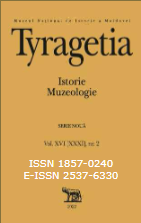Contribuții la dezvoltarea patrimoniului muzeal: colecționarul german Robert Denndorf
The contribution of the German collector Robert Denndorf to the development of museum collections
Author(s): Elena PloșnițăSubject(s): Museology & Heritage Studies, Archiving, Cataloguing
Published by: Muzeul Naţional de Istorie a Moldovei
Keywords: museum heritage; collection; print; value;
Summary/Abstract: One of the main functions of a museum is the formation and development of its collections of cultural goods. Without collections, a museum cannot carry out its activities. Museum collections are in constant development, and the main ways of this process are research, purchase and donation. In 2019, the National Museum of History of Moldova received a collection of cultural and historical goods from Germany as a gift from Robert Denndorf. This collection includes items belonging to different categories: old books, prints, maps, coins, medals. Among them, works of graphics – prints – are of particular interest, since they carry a double value load: on the one hand, artistic, and on the other, historical, which turns them into a true mirror of the era to which they belong. Since through art we can perceive the historical era, art can tell us about the views and beliefs of a society, and prints in this sense are artistic evidence of special value. Let’s pay attention to the engraving “Fighting on the Prut between the Turks and the Muscovites / Battle of Stănilești”. The work was done by the German engraver and publisher, Swiss-born Matthäus Merian, commissioned by the German historian Johann Abelin, known as Johann Ludwig Gottfried. It represents a general picture of the location of Turkish and Russian troops on the banks of the Prut before the battle of Stănilești (Vaslui County). The engraving was first published in 1715 in “Theatrum Europaeum”, a German historical journal published by Matthäus Merian from 1633 to 1738. The engraving-document “Fighting on the Prut between the Turks and the Muscovites / Battle of Stănilești” is one of the first depictions of scenes from medieval Romanian history, reflecting the event of the early 18th century – the Battle of Stănilești, which had important consequences for Moldavia and Wallachia. The town and fortress of Tigina (Bender) during the 18th-19th centuries were reflected in hundreds of pictorial evidences, including engravings. The town and the fortress were the subject of artistic inspiration for many artists, engravers, publishers, cartographers from Italy, Germany, Russia, Sweden. The collection of prints donated to the museum by Robert Denndorf includes two impressions depicting the town and fortress of Tighina (Bender): “Prospect der Stadt und Festung Bender” (“View of the town and fortress of Bender”) and “Cita e Castello di Bender” (“City and castle of Bender”). The print “View of the town and fortress of Bender”, made in 1771 by Gottfried Müller, depicts the fortress of Bender in the second half of the 18th century. The second engraving – “The City and Castle of Bender” – was made in 1795 by the Italian cartographer, publisher and engraver of the 18th century Antonio Zotta (1722-1804). The same collection, donated by R. Denndorf, includes 7 prints, which depict multi-figure compositions and battle scenes from Trajan’s Column. Trajan’s Column is one of the most majestic and impressive monuments of antiquity. This is an important historical source on the Dacian-Roman wars, since there are no ancient writings on these wars. Its documentary and historical value is enormous. This is a historical monument, but also a work of art, which is a source of inspiration for creative people. So, in the 17th century, the Italian engraver Pietro Santi Bartoli made dozens of engravings depicting scenes from Trajan’s Column. Some of them – the seven artworks donated by Robert Denndorf – entered the collections of the National Museum of History of Moldova. All prints donated to the museum by the German collector Robert Denndorf are examples of European engravings of the 17th-18th centuries; they are originals, made professionally and with great skill, and they are excellently preserved.
Journal: Tyragetia (Serie Nouă)
- Issue Year: XVI/2022
- Issue No: 2
- Page Range: 351-358
- Page Count: 8
- Language: Romanian

